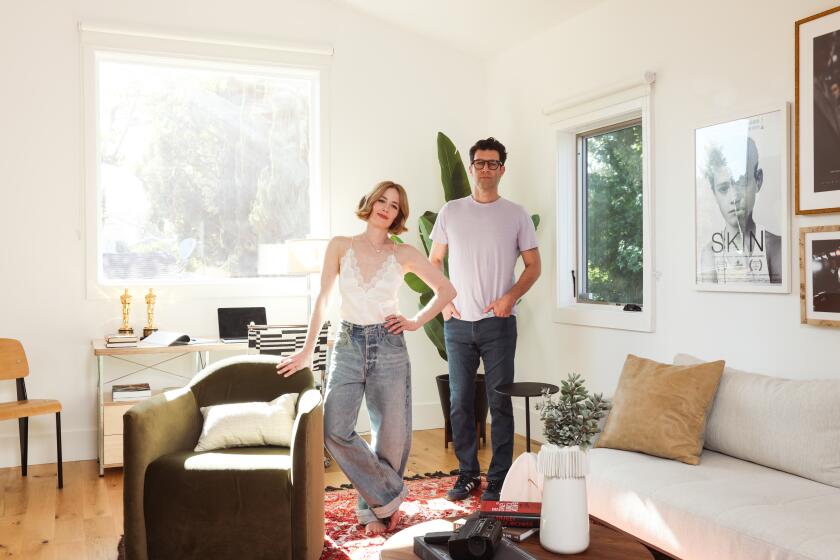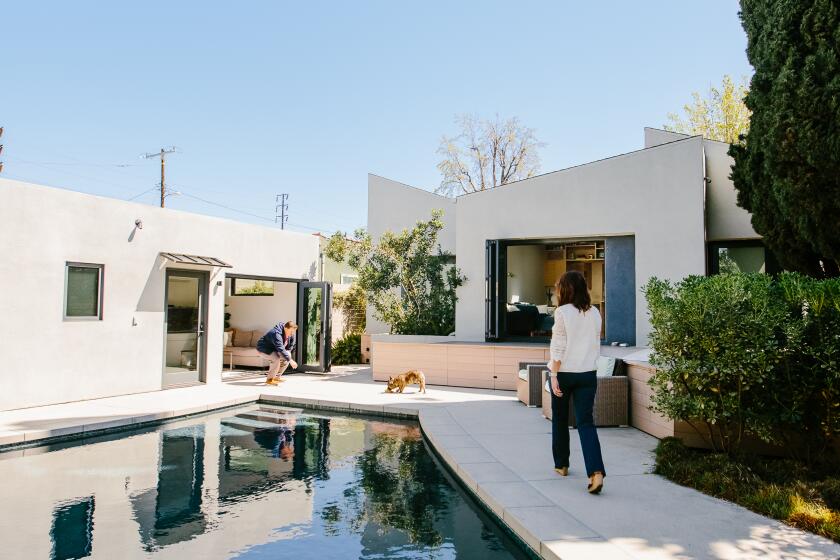In Santa Monica, a cubist design takes flight
When cinematographer Giorgio Scali first saw the design that Victoria Casasco had developed for a friend’s house, he was impressed by how the Santa Monica architect had referenced the Modernist work of the 20th century while still creating something that felt rooted in the 21st. The house wasn’t so much a copy of Midcentury Modernism but an extension of it.
His friend ultimately decided not to move ahead with Casasco’s design, so Scali moved ahead with Casasco himself. He hired the architect to build on a narrow lot he purchased in Santa Monica, east of Lincoln Boulevard, and he requested a house that expressed the same spirit that he had seen in his friend’s unbuilt plans. “I wanted to live in a home where you were led to understand and appreciate the great periods of modern design,” said Scali, whose credits include the forthcoming feature film “From the Rough” as well as award-winning commercials for brands such as Volkswagen and Mercedes-Benz.
After a number of delays, most due to getting intricate plans through the permitting and engineering phases, construction of Scali’s 3,000-square-foot home, with a second floor that seems to levitate, was finished last summer. Work on the interiors — the cinematographer’s project when he wasn’t on film shoots in Louisiana or at the Sundance Film Festival — was mostly wrapped up by early spring.
From the street, playful colored panels and glass fitted into an elegant black steel frame mask a plan that actually is much larger than its neighboring properties, relatively small homes built for workers of a Douglas Aircraft factory. There also is little hint about what lies inside: a home that is lined with glass yet still feels private, a soaring interior that opens to an imaginative courtyard and garden.
A spectacular steel frame allowed Casasco to incorporate an unusually wide range of features on a modest lot just 50 feet wide and 130 feet deep. Two 65-foot-long beams, placed on surprisingly thin-looking 5-inch-wide steel uprights, run the length of the house.
From this frame, the architect placed distinct cubes — a guest suite in front, the master bedroom high up at the rear, the kitchen off the side — all apart from the house’s core, a spectacular, glass-walled living and dining area with a ceiling rising 23 feet. Even the garage was turned into another glass pavilion. (As it sits in full view of the living room, its windows are frosted.)
Separating and elevating some of these spaces make the house as a whole feel larger. The guest bedroom feels as if it’s levitating, a sense of freedom created by Casasco’s cubist flight.
The architect’s balancing act plays other optical tricks. Stairs and a catwalk, both made from Brazilian teak, run along one side, up toward the open master suite. When viewed from below, someone heading upstairs almost looks as if he’s flying.
The advantages of the steel frame did not stop with the airy, elegant interior. The frame took only two days to erect. The architect emphasized that the material also is superior in an earthquake.
“I designed this modular system whereby panels, many made from perforated aluminum, others from cement, even glass, all pop into the frame,” she said. “In a seismic event, the steel may indeed bend a little, leaving these panels to pop back out. But bottom line: The house’s structure will remain very much intact.”
In day-to-day living, however, such benefits pale in comparison with one grand design gesture that steel afforded Casasco: The master bedroom suite hovers 13.5 feet above an outdoor living room.
Perched on cantilevered steel beams, the bedroom seems to float in midair. It shades an intimate conversation area below, a sunken courtyard that Scali furnished with teak chairs and sofas.
The outdoor room is surrounded by the floor-to-ceiling windows and sliding doors of the living area, the glass-walled garage and a small lawn and lap pool — more than fulfilling Scali’s request to his architect that he feel equally at ease outside as well as inside.
It would be easy to attribute Casasco’s imagination in steel to family background. Her father, Juan Casasco, was a well-known Argentine Modernist who worked with Mies van der Rohe. But Victoria, formerly a professor of architecture at Yale, said she was not particularly well-versed in her father’s accomplishments when she first designed Scali’s house in 2003.
She did not set aside time to reconstitute his archives and collect his drawings until a graduate student writing a thesis on her father approached her in 2007, Casasco said.
“I owe my decision to use steel to my background as a minimalist sculptor,” she said.
For his part, her client “brought such great familiarity with visual language to the project,” Casasco said.
It was Scali, a graduate of the School of the Museum of Fine Arts in Boston, who chose the colors for the exterior panels and other formal elements of the house. Aware of midcentury work by Charles and Ray Eames and Piet Mondrian decades earlier, Scali knew that “color would add a sense of playfulness to a home whose design ethos could have registered as far too serious.”
Scali was also a proponent of the black “datum line,” a steel ribbon 8 feet above the foundation that separates the upper and lower floors of the house. The cinematographer, however, took a much looser approach to furnishing his house.
“Because it’s so new, and to me, perfect, I wanted objects that were a little mixed up and funky,” said Scali, who shares the house with clothing designer Galadriel Mattei. So 1970s Italian pieces such as the Paracarro coffee table from Saporiti are mixed with classic Knoll chairs designed by Charles Pollock. Scali and his steel fabricator built the dining table out of the Brazilian teak left over from the stairs.
Rooftop solar panels satisfy all the house’s electricity demands, but for Scali, such practical features still can’t measure up to the simple joy of a house that opens up to the elements. Work takes the cinematographer all over the world, Scali said, but nothing matches the experience of walking out of his living room to the garden.
“It’s great to have a home that constantly reminds you what a wonderful place Los Angeles is to live in,” he said.
More to Read
The biggest entertainment stories
Get our big stories about Hollywood, film, television, music, arts, culture and more right in your inbox as soon as they publish.
You may occasionally receive promotional content from the Los Angeles Times.










